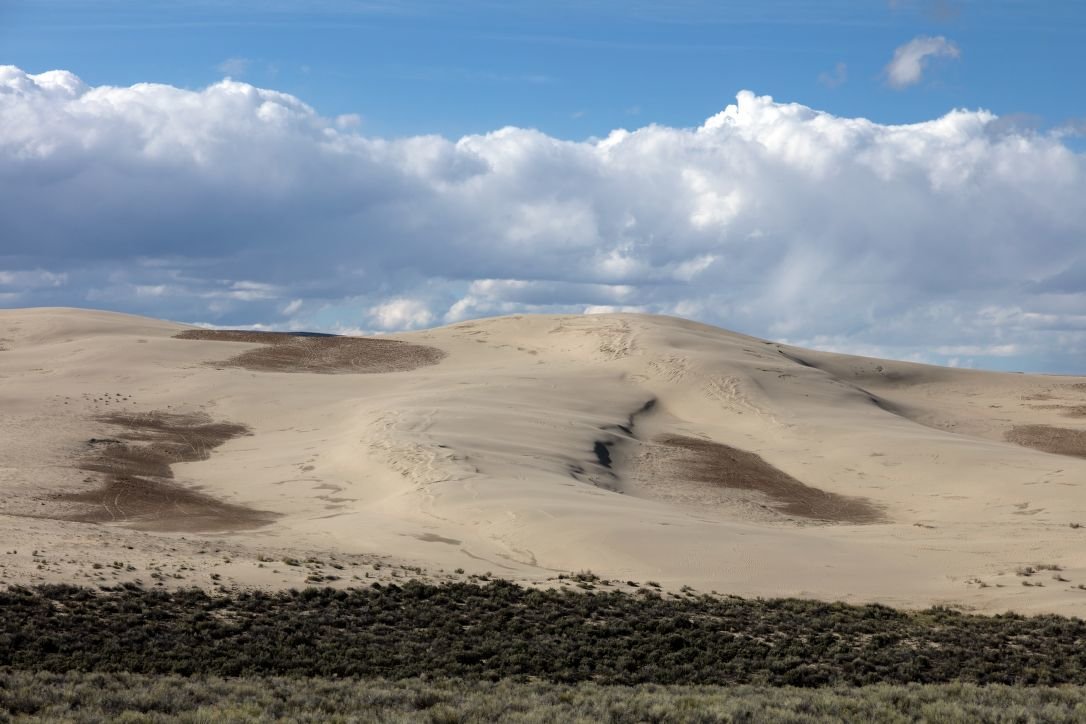The Ecology of Sand Dunes
Welcome back to another Story from the Wilderness! This time we’re talking about SAND DUNES! Why, you ask? During our 30-day pack trip, we spent the majority of our ride in Wyoming’s Red Desert. Turns out, there are huge sand dunes in this area and we were able to ride over some of them. They are a fascinating part of the Red Desert ecosystem so today we’re giving you a quick run-down on these amazing features!
The Killpecker Sand Dunes in Wyoming’s Red Desert (4).
Formation of Sand Dunes
Ok first things first: what is a sand dune and how is it formed? To start with the obvious, a dune is a mound of sand formed by wind (which there is plenty of in Wyoming). There are two sides to every dune: a windward side and a slipface (1). The windward side is, as the title suggests, the side where the wind is blowing and pushing sand up. The slipface side is the side without wind and is usually smoother than the windward side. Dunes are most commonly found in desert environments, but can also be found near water. They form in the desert because of a lack of moisture, which hinders the growth of vegetation and allows the sand to move more easily (3).
The sand dunes in the Red Desert (the Killpecker Sand Dunes) “formed about 1 million years ago when volcanoes spewed lava and hot ash over much of what is today Sweetwater County. Millennia of dormancy and wind erosion turned the volcanic materials into thousands of acres of exceptionally soft sand” (4). These dunes continued to form thanks to the Big Sandy and Little Sandy Rivers, “where large volumes of sand accumulated on their banks during glacial melting from the Wind River Mountains” (5). Over the last 20,000 years, Westerly winds have moved the sand eastward across the Continental Divide to their current location.
Killpecker Sand Dunes
Moose in the Red Desert, spotted by our film crew during our pack trip.
The Killpecker Sand Dunes are what we crossed during our pack trip through the Red Desert. These dunes, stretching 55 miles long over approximately 109,000 acres, are one of the largest in North America, and are the world’s second largest active* sand dune (6)(*active meaning the dunes are continually shifting due to winds). One vital function of the dune fields is storing snowmelt and rain which support vegetation and wildlife. Water seeps into sand where it is safe from evaporation. There are only a few plant species that can survive on the dunes which have access to the stored water and these plants help stabilize the sand by reducing wind. There are a few other species that inhabit these dunes such as dune beetles, shrews, white-footed mice, and kangaroo rats, which attract predators like owls and bobcats. Additionally, temporary summer ponds form at the base of the dunes and support migratory shore birds and waders, as well as large animals such as elk, cattle, sheep, and free roaming wild horses (in case you missed it, we rode through the Red Desert intentionally so that we could see the wild horses firsthand!). The fresh water also provides a habitat for aquatic organism such as salamanders and freshwater shrimp (5). Who knew there was so much life in a desert!
In fact, the Red Desert itself is home to 350 wildlife species and more than 1,000 plant species, including the largest migratory herd of Pronghorn Antelope in the lower-48 states and the world’s largest desert elk herd. It is the biggest unfenced area in the continental United States. There are three species protected by the Endangered Species Act in the Red Desert, the mountain plover being one.
The Red Desert is surprisingly and absolutely teeming with life and we were lucky enough to see it firsthand. We didn’t see much wildlife on the dunes themselves but during our ride through the desert we saw plenty of wild horses, Pronghorn Antelope, elk, deer, and birds of prey. The sand dunes were a really fascinating part of our ride, as they sort of just appeared out of the landscape in the desert. Were you surprised to learn how much life existed in this desert?
xoxo, Katherine & the wild women 💕
Bibliography
Cover Photo: Richardson, Helen H. “The Great Sand Dunes Are Lit by the Setting Sun on June 19, 2019 in Mosca, Colorado.” The Denver Post, The Denver Post, 15 May 2020, https://www.denverpost.com/2020/05/15/great-sand-dunes-national-park-to-phase-in-reopening-starting-early-june/. Accessed 29 Mar. 2022.
National Geographic Society. “Dune.” National Geographic Society, 9 Oct. 2012, https://www.nationalgeographic.org/encyclopedia/dune/.
Highsmith, Carol M, photographer. View of the tallest dune in North America at Great Sand Dunes National Park & Preserve, in the San Luis Valley near Alamosa, Colorado. -07-16. Photograph. Retrieved from the Library of Congress, <www.loc.gov/item/2017885073/>.
“Dune.” Wikipedia, Wikimedia Foundation, 24 Mar. 2022, https://en.wikipedia.org/wiki/Dune#Formation.
Highsmith, Carol M, photographer. View of the Killpecker Sand Dunes in Wyoming's Red Desert, north of Rock Springs. The dunes, formed about 1million years ago when volcanoes spewed lava and hot ash over much of what is today Sweetwater County. Millennia of dormancy and wind erosion turned the volcanic materials into thousands of acres of exceptionally soft sand, pldhigh to create a sandy playground, especially popular with those riding dune buggies. -05-23. Photograph. Retrieved from the Library of Congress, <www.loc.gov/item/2017688028/>.
“Red Desert (Wyoming).” Wikipedia, Wikimedia Foundation, 2 Feb. 2022, https://en.wikipedia.org/wiki/Red_Desert_(Wyoming)#Killpecker_Sand_Dunes.
Kohlman, Matt. “Life Abounds in the Largest Active Sand Dune This Side of the Sahara : Ecology: Wyoming's Killpecker Sand Dunes Are a Mile above Sea Level and 100 Miles Long. Environmentalists Hope to Keep Some of the Area off Limits to Dune Buggies and Other Human Intrusions.” Los Angeles Times, Los Angeles Times, 3 Jan. 1993, https://www.latimes.com/archives/la-xpm-1993-01-03-me-887-story.html.



